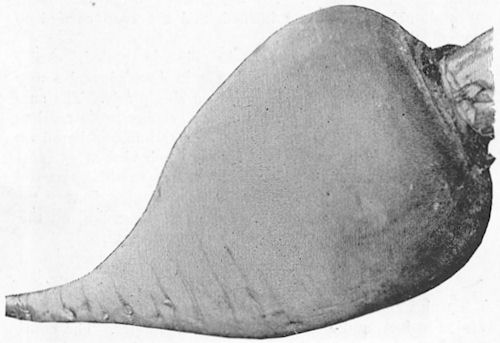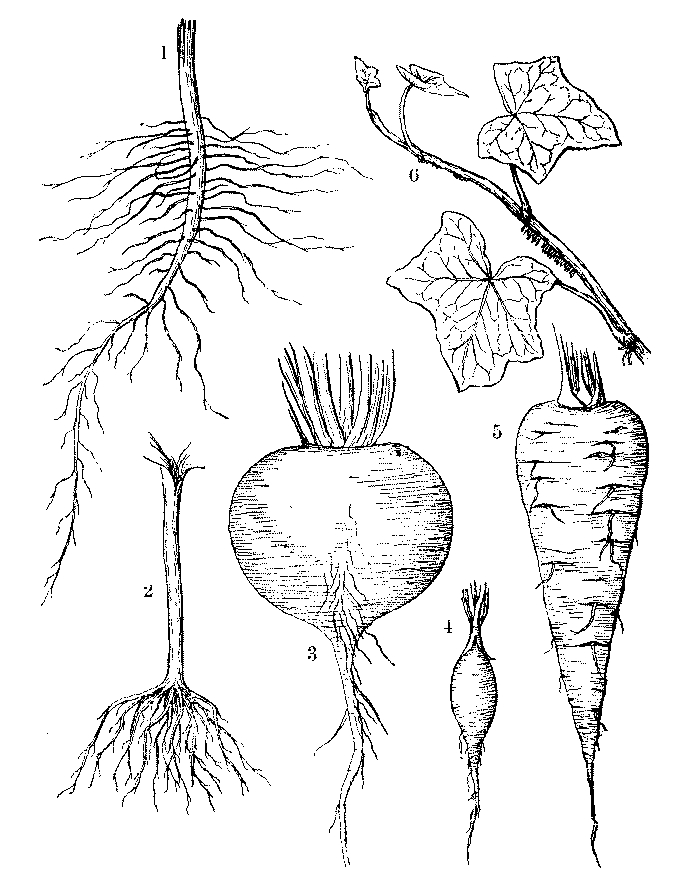In this brief essay, I will profile the word word for “turnip-shaped,” napiform. But first, why am I profiling napiform? I begin from there.

A Napiform Root Essay Prompt
As I am wont to do when I want to publish an article but time is short, I perused Project Gutenberg’s extensive library for source material. In the August 20, 1895 issue of the classic children’s magazine, Harper’s Round Table, I came across a charming essay by Caroline A. Creevy on the subject of “roots.” What kinds of roots do you ask? Plant roots:
When we are about to do a thing thoroughly and systematically we often say we will ‘begin at the root of the matter.’ That is because the root of a plant is supposed to be the first thing in its life. It is indeed the foundation, the substructure of a plant, but not strictly the first thing that starts to grow.
I read the essay and came across a fun word that I remembered I intended to one day profile at The New Leaf Journal.
Turnips bulge out in the middle, and are napiform.
“Napiform” was my trigger. Before The New Leaf Journal went live, I had intended to profile the word. Now is as fine a time as ever. Not too early and not too late, right in the middle of the napiform shape.
Classic Dictionary Definitions of Napiform
The meaning of the word napiform has not changed over the many years. However, since my prompt for this essay was its appearance in an 1895 magazine article, it makes sense to use relatively contemporaneous dictionaries to discern its meaning.
Century Dictionary
The 1889-91 edition of the magisterial Century Dictionary defined napiform as follows:
Having the shape of a turnip – that is, enlarged in the upper part and slender below…
Century Dictionary defition of “napiform”
Century also provided a usage example: “A napiform root.”
What is the etymology of napiform? The “napi” derives from Latin. “Napus” in Latin means turnip. “Form” should be obvious to English-speakers, but it derives from the Latin forma. This, napiform, broken down, means having the form of a turnip.
In showing how napiform derives from Latin, Century dictionary refers us to the word “neep.” What is the pertinent definition of neep?
A turnip.
Century Dictionary definition of “neep”
Apparently “neep” also means turnip. But by 1889-91, it was obsolete except in Scotland. It is and was also somewhat common in the American south. See this article from The Guardian discussing which turnips “neep” refers to.
Webster’s 1913
Webster’s 1913 has a similar definition of napiform to Century dictionary:
Turnip-shaped; large and round in the upper part, and very slender below.
Webster’s 1913 definition of “napiform”
Webster’s 1913 offers napiforme as an alternative spelling, although I have never seen it used.
The napiform definition refers readers to the word navew:
A kind of small turnip, a variety of Brassica campestris.
Webster’s 1913 definition of “navew”
That word can also be spelled naphew.
Webster’s Second (1952)
Finally, I turn to my original 1952 Webster’s New International Dictionary: Second Edition Unabridged. It is a bit removed from Century and Webster’s 1913, but it remains an enduring classic reference. It made one photographic appearance in The New Leaf Journal before. Since I paid good money for the very large book, I figured that I ought to make use of it here at The New Leaf Journal. Webster’s Second defines napiform as follows:
Turnip-shaped; large and round above, and tapering abruptly below; – of roots.
Webster’s Second definition of “napiform”
This is, in my view, the best and most clear of the three definitions. “[T]apering abruptly below” is an elegant way of describing the progression of the shape from its “large and round” top to its slender bottom. It also adds the point that napiform can be used to refer specifically to roots. Well done, Webster’s Second.
A Botanical Usage Case of Napiform
Jane H. Newell provided an interesting list of terms to describe the myriad shapes of root vegetables in her 1888 Outlines of Lessons in Botany:
The root of the Radish is different from any of these; it is fleshy. Often, it tapers suddenly at the bottom into a root like that of the Morning-Glory with some fibres upon it. It is, in fact, as the Morning-Glory would be if the main root were to be thickened up by food being stored in it. It is a primary tap-root. The radish is spindle-shaped, tapering at top and bottom, the carrot is conical, the turnip is called napiform; some radishes are shaped like the turnip.

The turnip is the only one of the common root vegetables with a specific English word to describe its shape. This passage is notable in that it is our only usage case that applies napiform to something other than a turnip. Note that Newell observed that “some radishes are shaped like the turnip.” That is, some radishes are napiform.
A Napiform Conclusion
Caroline A. Creevy’s essay ended with a moral about plant roots and people:
So, you see, appearances are deceptive, and in plants, as well as people, you cannot always tell character from the outside.
That was well put. But while it may not always be possible to ascertain character from the outside, it is possible to discern whether something is napiform from the outside. That is, lest one can have napiform character or a napiform heart – in which case the cover may not tell the entire napiform story.